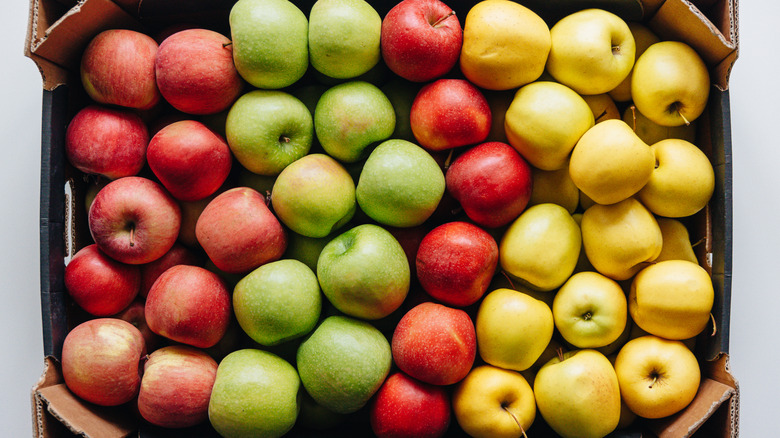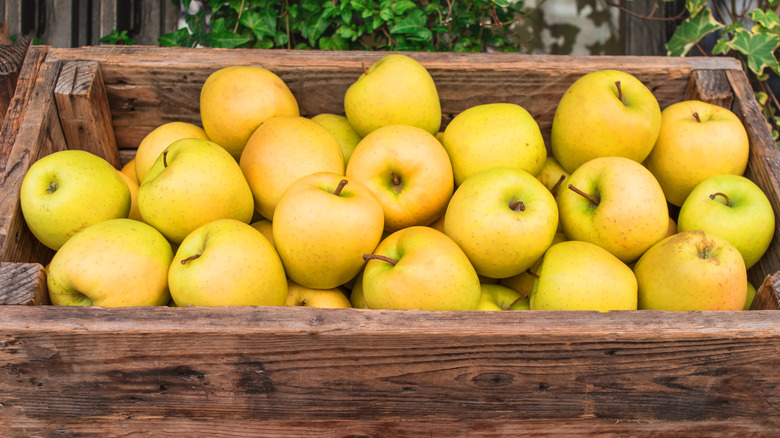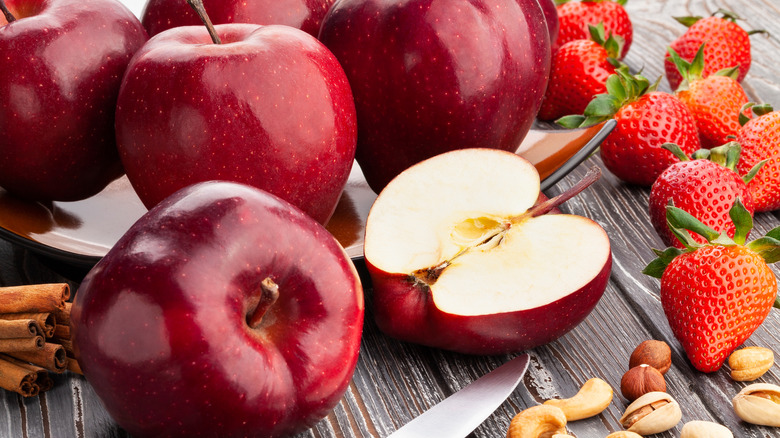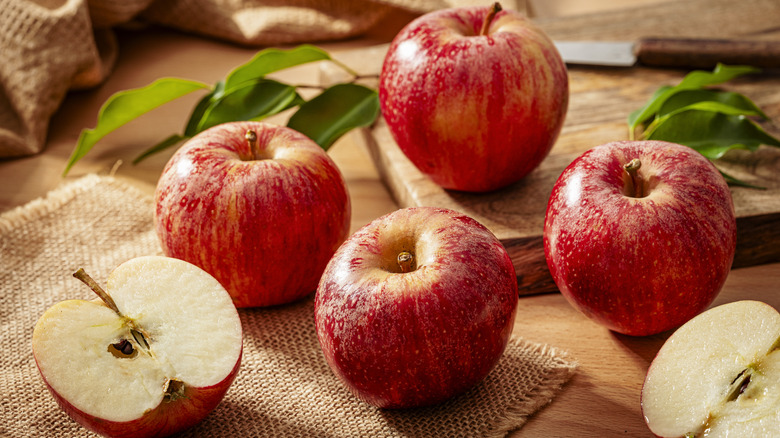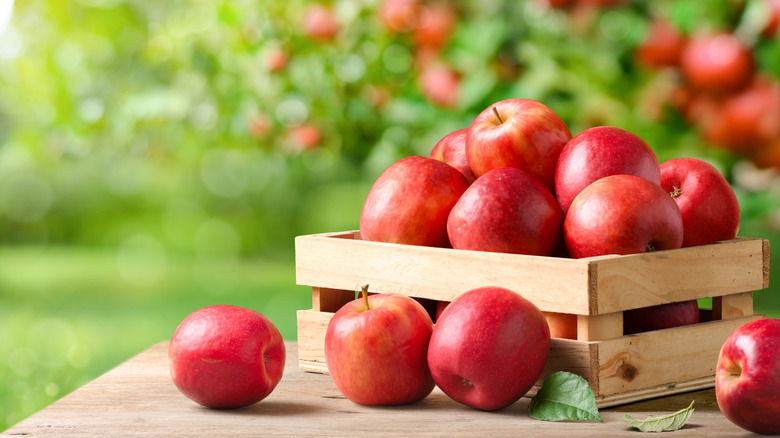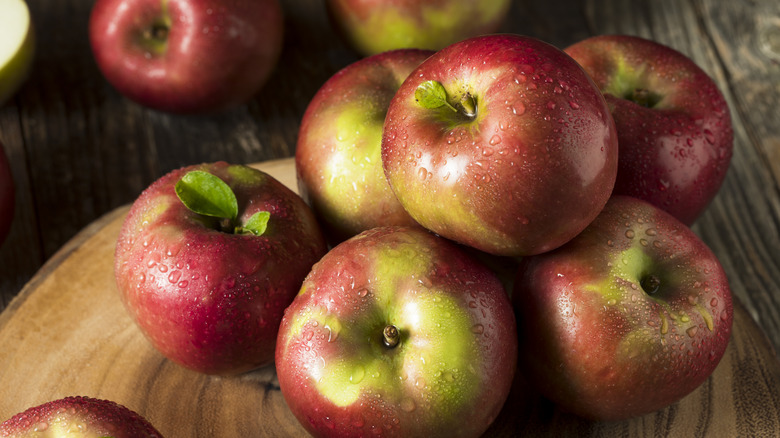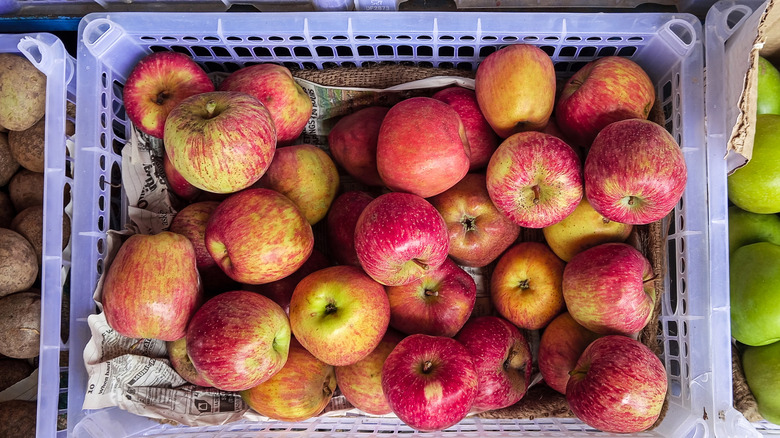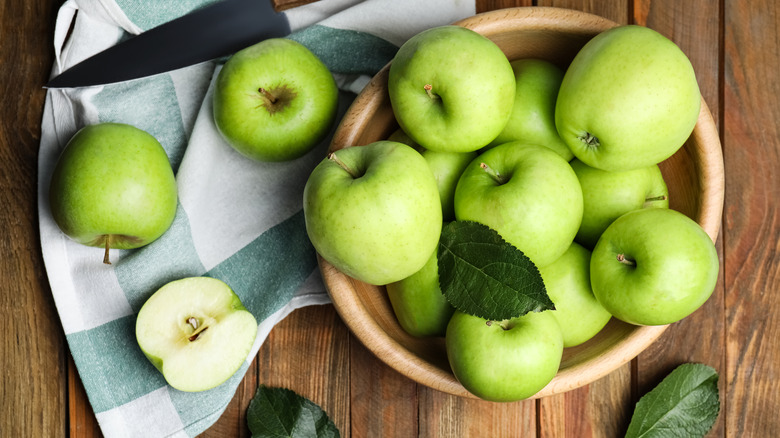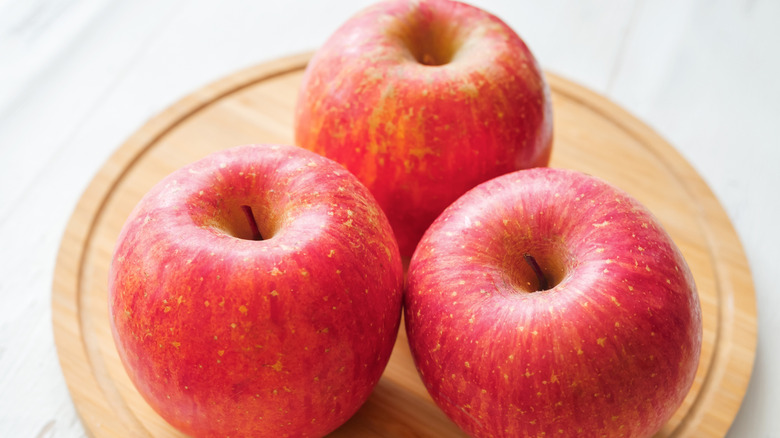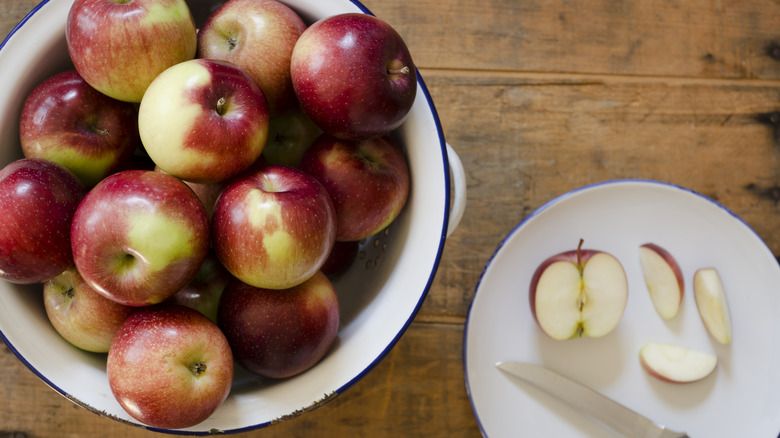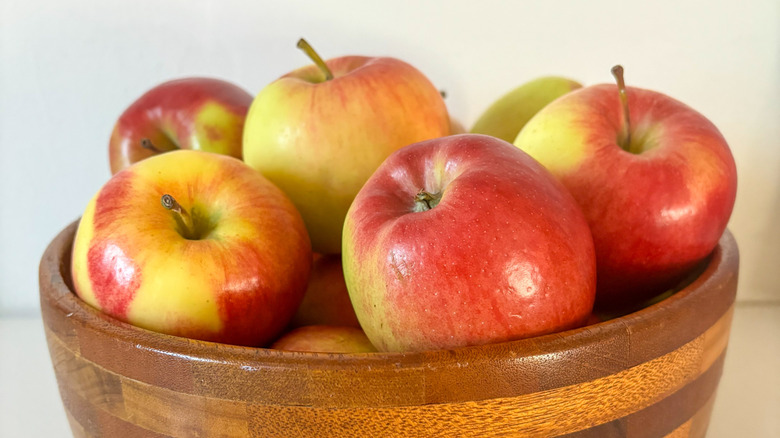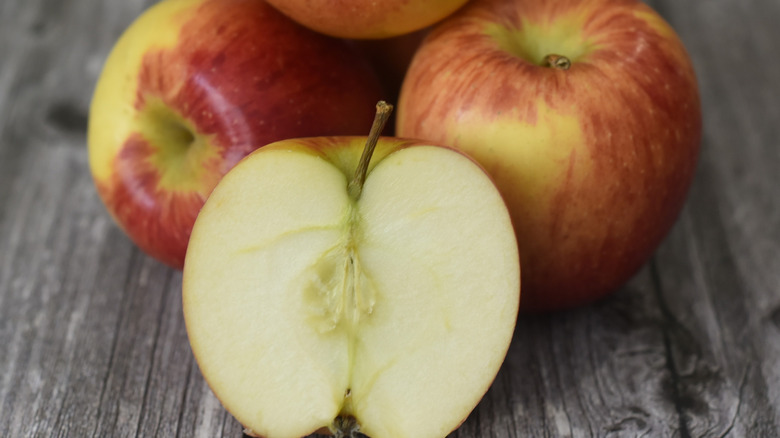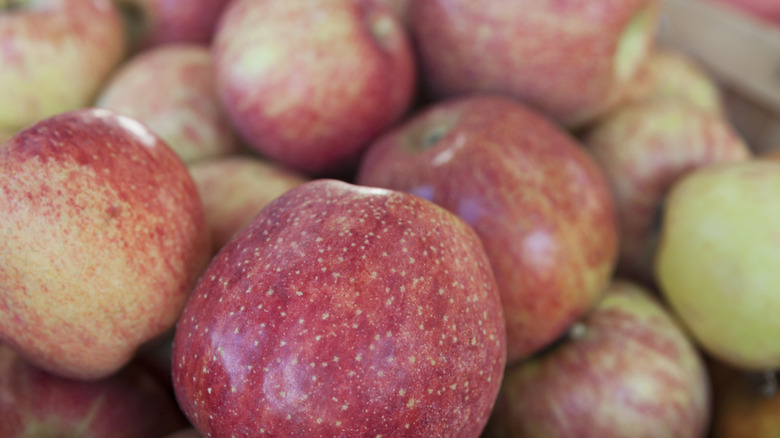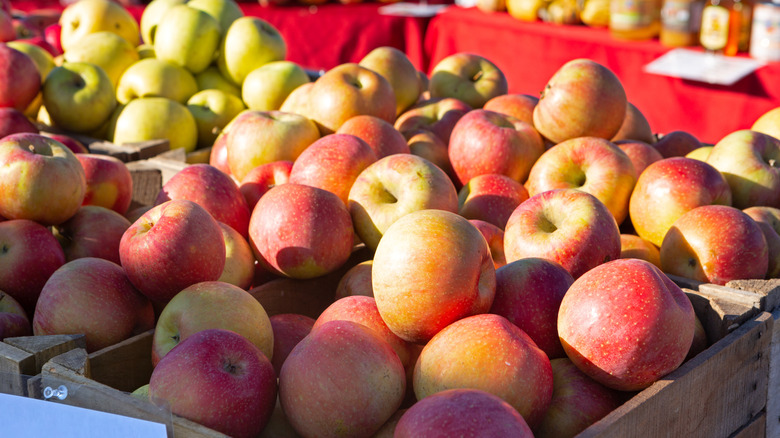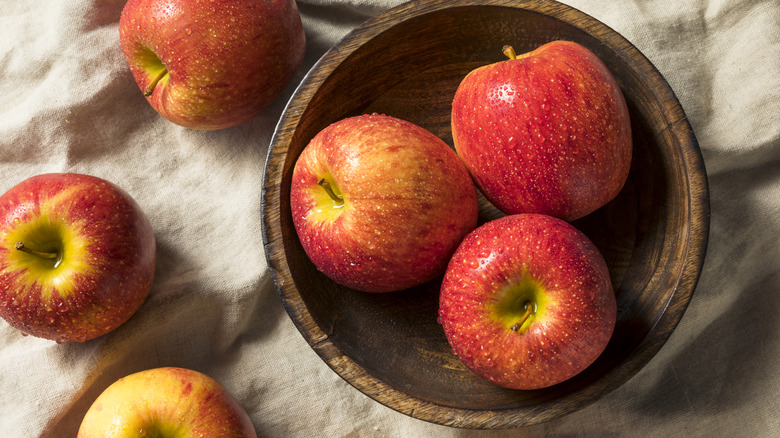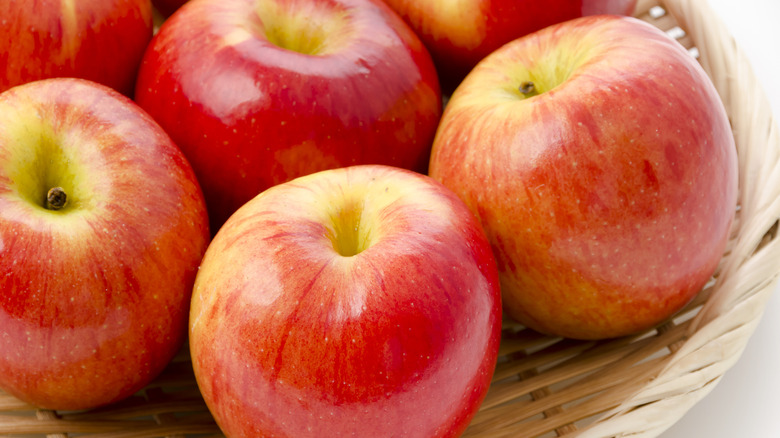15 Types Of Apples And The Best Ways To Cook With Them
Back in childhood, many of us thought there were just two apple varieties –– green and red. But now that we're adults, it can be a little overwhelming walking through the grocery store's produce aisle. Although thousands of apple types have disappeared, the U.S. currently grows more than 100 varieties, each with its own distinct flavor, texture, and varying levels of sweetness and acidity. From crisp Granny Smith to the sugary Fuji or Gala, every type has a culinary personality to celebrate.
Choosing the right apple to cook with is a bit different than picking the perfect one for snacking, as you'll need to know how it complements the other ingredients in the dish. Additionally, some are more heat-tolerant, while others work best in cold salads. If you want to get creative in the kitchen, you could even mix several types of apples in one dish to achieve a layered complexity of flavors and textures. We've broken down several varieties of apples and how to choose the ideal one for your recipes.
Golden Delicious
If you only want to have one type of apple in your pantry, consider making it Golden Delicious. These pale yellow beauties bring a mellow sweetness and crispness to a variety of different recipes, and are tasty enough to snack on by themselves or paired with cheese and crackers. Golden Delicious apples are popular for cooking because they're known to retain their shape and texture, without getting mealy and mushy. They're also visually appealing, making them ideal for cozy apple recipes in the fall.
Golden Delicious apples have low acidity and a honey-like flavor that complements rich ingredients. Their flavor is so gentle that they work equally well in both sweet and savory dishes, and they can be baked into tarts, pies, and crisps. They also pair especially well with warm spices such as cinnamon and nutmeg. Fold them into a bold holiday stuffing, chutney, or serve them alongside pork.
Red Delicious
Known for their deep red, crimson-hued skin and elongated heart shape, Red Delicious apples have been a school lunch icon, as well as a fruit bowl staple, for years. Their flesh is mildly sweet with a mellow flavor and has a low acidity. Featuring a slightly mealy texture, Red Delicious aren't the crispest of apple varieties. Their softer flesh makes them ideal for fresh snacking, but less suited for cooking.
When they're exposed to high heat, Red Delicious apples may break down quickly, losing some of their structure and turning mushy. This limits their use in baked goods and sauteed dishes, but their gentle flavor and crisp skin make them perfectly suited for chilled dishes. For instance, you can slice them up into salads or sandwiches for subtle sweetness and crunch. While they might not be your go-to apples for baking, they offer a bushel of nostalgic charm.
Gala
Originating in New Zealand, Gala apples are beloved for their mellow sweetness, cream-colored flesh, and appealing yellow-streaked red skin. The apples are also known for their crisp texture, making them a favorite for snacking on fresh. Their flavor is subtly floral with hints of vanilla and honey, and they're less tart than varieties such as Granny Smith. Gala apples' versatile flavor makes them ideal for several different cooking options.
In the kitchen, Gala apples work best in recipes where their natural sugars can shine, such as sauteing them to serve alongside pork chops or adding them on top of overnight oats. When heated on the stove top or in the oven, Galas soften quickly, making them perfect for applesauce or butter. They also hold up well in baking, offering firm slices for pies, tarts, and other baked goods. These versatile apples are great to have on hand for both sweet and savory recipes.
Pink Lady
Best known for their charming name and pretty rose hue, Pink Lady apples bring a lively balance of sweetness and tartness to any dish. Their crisp texture and vibrant blush make them attractive snacking options and lunch box favorites. They also tend to brown more slowly than other varieties. Their firm flesh holds up well under heat, making them one of the best apples for baking, sauteing, roasting, and even grilling. If you use Pink Lady in pies and tarts, you can count on the slices to retain their shape and offer a bright, nuanced flavor.
These versatile apples pair well with warm baking spices such as cinnamon, nutmeg, cardamom, and ginger. When caramelized, their natural acidity cuts through rich, savory dishes such as grilled chicken or roasted root vegetables. Pink Lady apples are also ideal for sandwiches and salads, where their crunch and tang add contrast to creamy cheeses, spicy meats, and bitter greens.
McIntosh
First cultivated in 1811 by John McIntosh, McIntosh apples are cherished for their refreshing juiciness, tender flesh, and tangy-sweet flavor. Their skin is deep red with green undertones, making them as easy on the eyes as they are on the palate. McIntosh apples make satisfying fresh snacks, but they're also revered in the kitchen. When cooked, their tender, juicy interior softens quickly, making them ideal for sauces, applesauce, apple butter, and baked goods that call for a melt-in-your-mouth texture.
Tasting like autumn in every bite, McIntosh apples also shine in stovetop preparations due to their fast breakdown, which creates velvety compotes or fillings. They tend to soften so quickly that you may need additional thickener in your preparations. Although they may be a bit too delicate for long roasting and grilling, their nostalgic taste and gentle acidity make them a favorite for recipes that celebrate warmth and the fleeting sweetness of fall.
Honeycrisp
Although some may say that the quality of Honeycrisp apples has declined, this variety offers an explosive crunch and perfect balance between sweet and sour. Bursting with juiciness, Honeycrisp apples are beloved for their flavor and mottled red and yellow skin that perfectly celebrates all things autumn. Another reason people love them is that their flesh stays firm when cooked, making them a versatile choice for both raw and heated preparations. When Honeycrisp slices are baked into crumbles, pies, and other flaky desserts, they hold their shape and lend both texture and a gentle sweetness.
The apples' natural sugar content allows them to caramelize well, making them ideal for roasting alongside savory ingredients like squash or leaner meats. Honeycrisp apples also shine in salads, where their crisp sweetness contrasts with savory elements such as rich cheeses and nuts. They also complement all types of lettuce and hearty greens like kale.
Granny Smith
Even though they have a sweet name, Granny Smith apples are known for their bold tartness that starts with a crisp snap and ends with a mouth-puckering zing. The popular apples feature vibrant green skin, a firm texture, and a high acidity level. Their dense flesh holds its shape beautifully under heat, making them ideal for cooking. They can also stand up to both savory and sweet recipes. When used in baked goods alongside sweeter types like Gala and Fuji, Granny Smith apples offer structure and an intriguing contrast.
If you want to use these apples in savory dishes, you can't go wrong pairing them with rich meats like duck or pork. You can also use them to make mouthwatering chutneys or add them to roasted vegetable medleys. The versatile Granny Smith is just as delicious baked and sauteed as it is sliced over salads and into sandwiches. Another benefit of these apples is that, due to their firm skin, they don't bruise or brown easily, which extends their shelf life.
Fuji
Another type of apple revered for its crisp texture, dense flesh, and high sugar content, Fujis are one of the sweetest apples in the world. If you've got an insatiable sweet tooth, Fuji apples are the perfect choice. Their flavor is a blend of honey and subtle floral notes, with just a touch of acidity to balance it out. When cooked, firm Fuji apples hold their shape well, making them ideal for roasting and sauteing. You can also layer them into tarts and pies for structure and taste, and they're one of the best varieties for hot apple cider. However, due to their mild flavor, they're less suited for baked goods that call for a tart bite or strong apple presence. Since they're so sweet, you might also consider using less sugar in the recipe.
Fuji apples work well in savory dishes such as roast duck and fresh salads, where their sweetness adds contrast to the saltiness. As a light lunch or protein-rich snack, consider topping Fuji apple slices with peanut or almond butter.
Empire
A combination of McIntosh and Red Delicious, Empire apples feature the best characteristics of the two varieties. The apples are a delightful blend of sweet and tart, and have a crisp bite that is more robust than milder varieties, such as Gala. With a deep red skin reminiscent of autumn, Empire apples are also aesthetically and aromatically pleasing.
Due to their perfectly balanced flavor and crunchy flesh, these apples are ideal for snacking as they are. With a juicy snap, each bite is as refreshing as it is flavorful. When it comes to cooking, they hold up well at high temperatures, and they're versatile enough for various recipes, including roasted preparations, ciders, tarts, crisps, and easy apple pie recipes. In baking, the apple slices will keep their shape without getting mushy. Empire apples also complement savory dishes, and would work wonders sauteed with onions and folded into a festive stuffing.
Ambrosia
Discovered in British Columbia by chance in the late 1980s, Ambrosia apples are prized for their sweetness with nuances of honey, low acidity, and a crisp, juicy texture. Their firm flesh holds up well in both raw and cooked dishes without becoming mushy. Another plus is that their creamy white flesh is slow to turn brown, which comes in handy for salads, cheese boards, and slaws. These apples lend a mellow richness to baked goods, including muffins, cakes, and tarts, where their natural sugars gently caramelize. Recipes like baked mini apple fritters seem to have been made for Ambrosias, since they dice up easily and complement the spicy cinnamon flavor.
If you want to cook with Ambrosia apples, you're in luck. Due to their firm texture, they're perfect for roasting and sauteing, and pair well with warm spices and savory elements such as pork and sage. Dice them up into a holiday casserole or stuffing blend, or saute them with onions to smother over a variety of meats.
Braeburn
First cultivated in New Zealand during the 1950s, Braeburn apples are known for their balanced flavor and strong, colorful skin that is highly resistant to bruising. Their firm, crisp texture is perfect for a variety of cooking techniques, and they have a complex flavor profile that complements both subtly spicy and citrus notes. This makes Braeburns your go-to apples for everything from sweet to savory recipes. The apples are also aromatic and have low acidity levels, providing ample room for pairings. Because they're so juicy and refreshing, consider eating them slightly chilled for the most satisfying crunch.
Like other firm-fleshed apples, Braeburns work well grilled, roasted, or sauteed, and are delicious served alongside chicken, sausages, or pork. They also give depth and texture to stuffing, chutneys, and casseroles. When you need a versatile apple with a vibrant flavor and sturdy texture, look no further than Braeburns, which are typically in season during mid-fall.
Cameo
If you can't decide between eating an apple or a pear, biting into the firm flesh of a Cameo apple may be the perfect option. They are refreshingly crisp and sweet, with a touch of tang for balance. With hints of citrus, spice, and a slight pear flavor, their unique taste sets them apart from many other types of apples. What also makes them stand out is their flesh that resists browning, making them perfect for salads, snacking, and lunchboxes. They also hold their shape well when sliced and cooked.
Fold Cameo apples into pie filling, crisps, galettes, or cut them in half and bake with a sprinkle of cinnamon sugar. On the more savory side, Cameo apples complement spreads featuring sharp cheeses, and also work well in soups, meatballs, and salsas. No matter how you want to enjoy Cameo apples, they bring a balanced brightness to every recipe they star in.
EverCrisp
Crunchy, sweet, and juicy, EverCrisp apples live up to their name with an outstanding crunch and a long shelf life, making them ideal for both snacking and cooking. The attractive, rosy red apples peak in mid-fall and will typically last for months in storage. A cross between a Honeycrisp and Fuji, EverCrisps have a complex flavor profile, delivering hints of caramel and spice with a sweet, dense flesh.
Perfect for both fresh snacking and cooking, these apples won't turn mushy when subjected to high temperatures. Because they're so sweet, you may be able to reduce the amount of sugar you add to baked goods, sauces, and compotes. You can go old-fashioned by folding them into a tart, or get creative and add slices to a cocktail. Whether they're tucked into flaky desserts or crumbles, EverCrisps bring plenty of orchard-fresh flavor to the party. Just be sure to macerate your apples for the best-tasting pies.
Envy
Another variety that originated in New Zealand, Envy apples are celebrated for their crisp texture, full-flavored sweetness, and low acidity, making them perfect for snacking as they are. The luxurious apples are also ideal for culinary use, since their flesh is dense and slow to turn brown. Try slicing them into gourmet salads or sandwiches, or adding them to cheese boards and other decorative dishes where the appearance of the fruit matters.
Beloved for their smooth taste and almost tropical flavor, Envys also have a touch of floral undertones, which adds elegance to any dish they're in. The firm-fleshed apples are just waiting to be added to savory recipes, including roasted meat dishes, casseroles, and stews. If baked treats are more your thing, use them to make mouthwatering strudels, cakes, and cookies. Because they hold their shape so well, you could also stuff and bake Envy apples for an eye-catching fall treat.
Jazz
Liven up rich dishes, snack plates, or your favorite baked goods with bright and flavorful Jazz apples, which are a cross between Gala and Braeburn varieties. These bold apples have a dense, crunchy texture, and stand out best in recipes that call for a bit of contrast with sweet, fruity notes. Whether you need them to bake into a pie or fold into autumn-inspired bread dough, Jazz won't disappoint.
Their taste leans toward tangy with hints of citrus and spice, making them ideal for a variety of sweet and savory recipes. Like many other types of apples, Jazz makes delicious bars, tarts, and crisps. They also play nicely alongside roasted vegetables or on a charcuterie board filled with cheese, nuts, and cured meats. You could also use this variety to whip up an easy apple butter recipe. Whether you want to enjoy Jazz apples raw, sauteed, or baked, you'll have no shortage of options.
